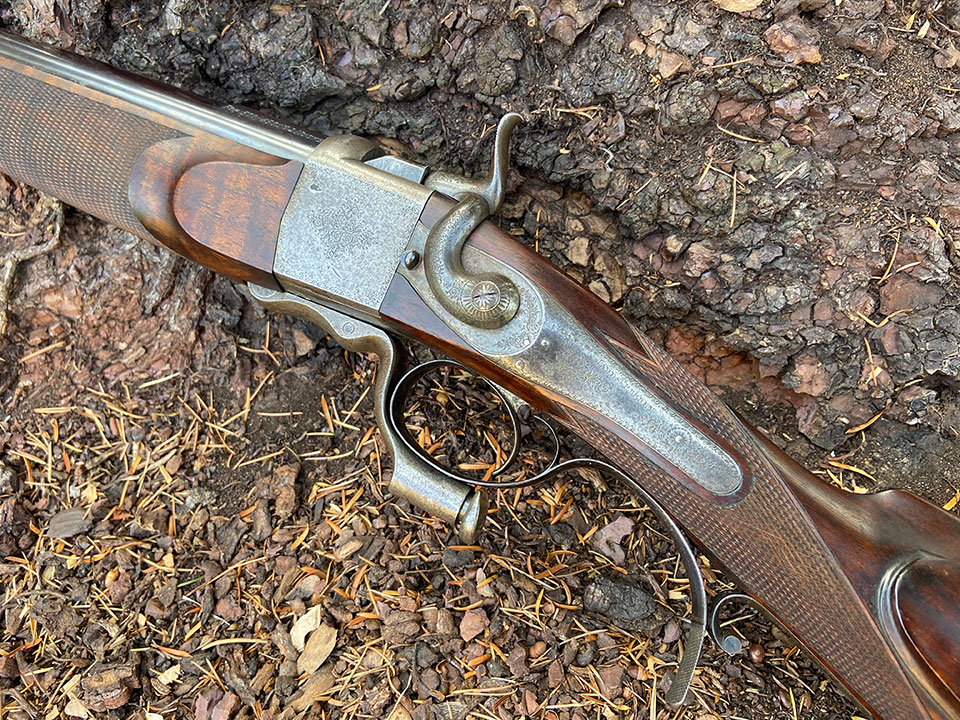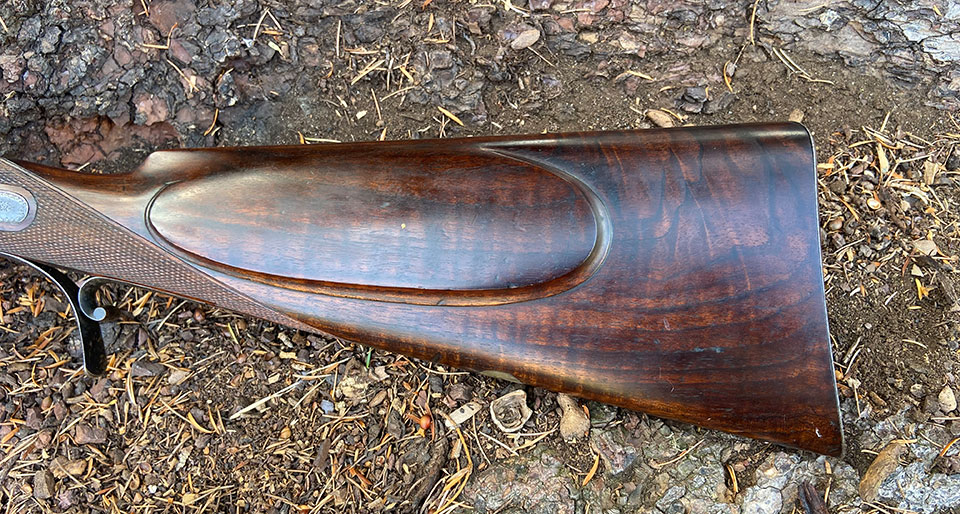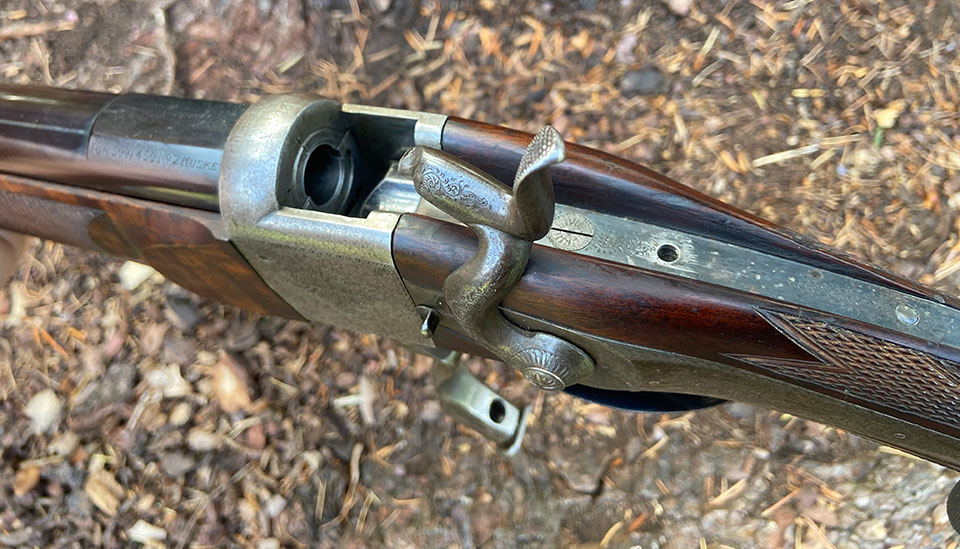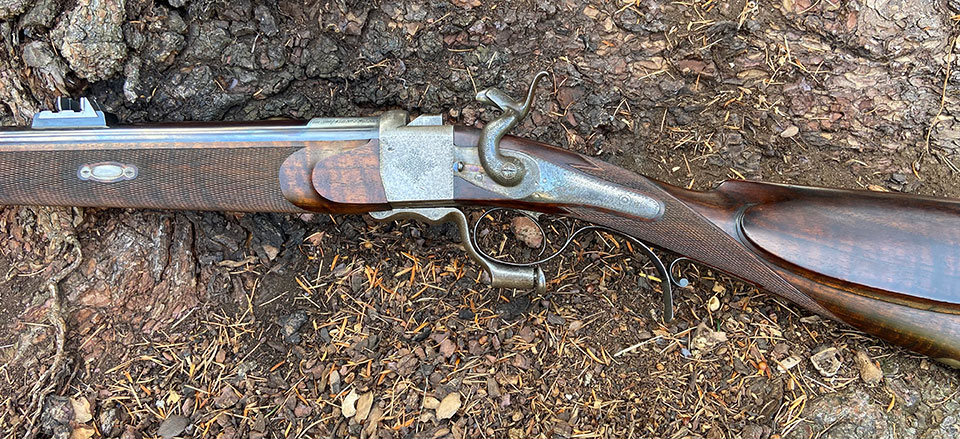‘Henry’s Patent A No.18’ is engraved on the top of the action, where the barrel screws into the breach, but the name on the lock is ‘James Purdey’, while on the barrel it is styled ‘James Purdey & Sons, 314 1/2 Oxford Street, London’.
Already, this falling-block, side hammer rifle is a conundrum.
Looking at it, the first thing anyone would notice is the very heavy barrel, with its unfinished sights (a ramp and blade foresight and a standing rear sight with two folding leaf sights). It is what one might expect to find on a target rifle.

The 14 1/2: stock with cheek-piece on the left (for a right-handed shooter) is in good condition and of nice, dark walnut.
It has a steel skeleton pistol grip, engraved with Purdey serial number 9532, dating it to 1875. The chequer to the hand has been re-cut and the forend is, I would think, a new one, though if it is, it is perfectly executed.
The barrel too, is of recent manufacture.
The action, referenced earlier in the engraving of the Henry patent, is made to Alex Henry’s patent No.1071 of 1865. Purdey made only forty-one ‘Purdey/Henry’ rifles between 1857 and 1879, so if this is a genuine Purdey-retailed rifle, it is quite uncommon.

These Henry-patent rifles were mostly supplied to Purdey by Samuel Allport of Birmingham and finished in London to Purdey standards. The left hand lock-plate has a bolted hammer, which was only fitted to higher quality rifles.
The serial number is sequential to other known Purdey/Henry rifles of 1875, so that is reassuring, though there is a question over the name on the lock plate. The name is engraved ‘James Purdey’.
This is disconcerting, as in the 1870s Purdey locks were engraved ‘Purdey’ and the barrels ‘J.Purdey, 314 1/2 Oxford Street, London’. The firm did not trade as ‘James Purdey & Sons’ until 1877. So, we can conclude that while the serial number is convincing, the name and address on the barrel is wrong for 1875 and the engraving on the lock is wrong as well.
It was also supplied with loading dies and a hundred and fifty brass cases.
While we contemplate these inconsistencies, we can look at other features of the rifle. Engraved on the breech end of the barrel is; ‘For .500/.450 No.2 Musket’. It was also supplied with loading dies and a hundred and fifty brass cases. Apparently a .45-70 bullet will fit well and perform, should re-loading be undertaken. This chambering does, of course, fall under the ‘Obsolete’ category according to Section 58 of the current Firearms Act, so the rifle can be owned and kept without a licence as a curio or ornament.
For those wondering if that status is compromised by the fact that it has a new barrel; the answer is ‘no’, since it is in the original chambering.
The .500/.450 No.2 Musket is a (relatively uncommon) 2 5/8” bottle-necked, drawn-brass case, filled with 76 grains of black powder and topped with a 480 grain bullet. Vintage rifle re-loaders consider it to be a very effective and comfortable cartridge to shoot. It actually originated at Westley Richards.

The action is familiar to most vintage rifle enthusiasts. It was one of the earliest and best single-shot sporting rifles of the 19th century. The left hand lock on a right-handed rifle allows for easy re-loading, as the right hand can place a new cartridge in the breech without having to contend with a hammer blocking the route, as it does so.
The falling-block is activated by a strong lever under the guard, held in place by a push-button release that is not entirely dis-similar to the one Adams used on his pinfire shotguns (Patent 285 of 1860). The solid breech-block descends as the lever is pushed forwards. Once loaded, the lever is pulled back into place, where it locks shut and the block seals the breech.
A striker is housed within the breech block and protrudes sufficiently to be struck by the falling hammer, thereby detonating the cartridge. The hammer has a two-stage action with half and full cock and does not rebound.
The entire design gives the impression that it is efficient, ergonomic and robust. It is beautifully made and an impressive feat of engineering. It is also simple and lends itself to manufacture by machine.
“Purdey have the records for it. It was sold to the Earl of Dunraven in Ireland."
When I bought the rifle, I was told by the vendor “Purdey have the records for it. It was sold to the Earl of Dunraven in Ireland". He was an interesting man who even acquired thousands of acres of land in the USA for sporting shooting. The rifle had a brand new barrel fitted by Purdey many years ago (by Arthur Smith in Essex who made all their rifle barrels) – so has all authentic and correct markings engraved. Only ever proof fired since I think and the rear sight not even filed/regulated for longer distances”.
So, if that is all true, the rifle was someone’s unfinished project. Perhaps the action was separated from the barrel decades ago and someone decided to make it into a target rifle for vintage competitions. The new barrel is certainly beautifully made, with proper Henry rifling, but if sanctioned by Purdey, why the erroneous ‘James Purdey & Sons’ style on the barrel, rather than the, correct for 1875, ‘J. Purdey’?
The only way to solve these questions once and for all was to call Nick Harlow at Purdey and see if the records could divulge any more information on the rifle. Purdey records are often very detailed but can be scattered around the many different books used by various departments during manufacture.
What came back from Nick was confirmation that the serial number was for a Purdey/Henry .500/.450 sold to the Earl of Dunraven but it appears to have been returned. It was noted in Purdey’s stock checks in 1895 and 1896 and seems to have been kept at Audley House into the 1930s. Some records suggest it had extra barrels. There is no record of it having been re-barrelled.

In practical terms, this rifle would be worthy of finishing-off and regulating for use in vintage rifle target shooting competitions. The heavy barrel would suit that purpose very well indeed. Mechanically it is in excellent order and it could have a long, productive life ahead of it.
As for the ‘James Purdey’ engraved on the lock, there is no clear answer, perhaps the engraver just had a moment. I recall seeing a Purdey hammer gun once with ‘Purdey’ engraved on one lock upside down!
Published by Vintage Guns Ltd on (modified )




